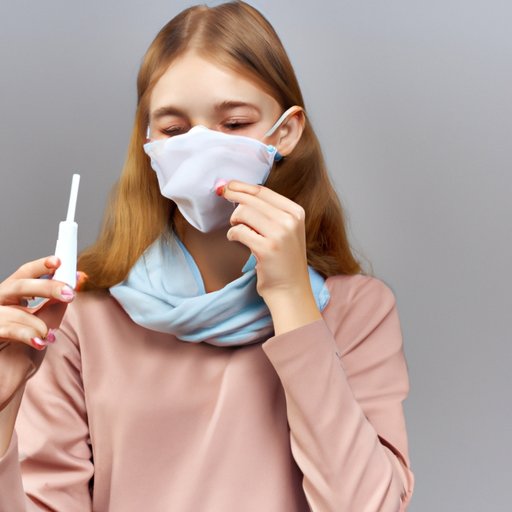
Introduction
Everyone dreads getting sick, especially during the flu season, but between the flu and a common cold, it might be hard to tell what someone is suffering from. Knowing whether you have a cold or the flu is important, as treatment may vary and missed diagnosis may lead to complications. In this article, we will look at how to know if you have the flu, the difference between the flu and the cold, flu tests, risks for the flu, prevention methods, and treatments.
Symptoms of the Flu
The flu is a contagious respiratory illness caused by the influenza virus. Flu symptoms are similar to those of a cold but are more severe and develop rapidly, within one to three days after exposure. Flu symptoms may include:
- Fever
- Cough
- Sore throat
- Body aches
- Headaches
- Fatigue
- Chills
- Runny or stuffy nose
- Vomiting and diarrhea (less common in adults)
Note: Some people may experience different symptoms, and some may have no symptoms at all, though they can still pass the virus to other people.
It is vital to recognize these symptoms early, as the sooner you start treatment, the faster you will recover, and the less likely you are to spread the virus to others. If you or someone around you has flu-like symptoms, know the signs of illness and seek medical attention if needed.
Difference between the Flu and a Cold
While flu symptoms are similar to those of the cold, there are a few distinguishing factors between the two illnesses. In general, the flu symptoms are more intense and severe, while cold symptoms are milder. Flu symptoms are also more sudden than the common cold, which usually develops gradually over several days.
It is important to differentiate between the two illnesses because their treatments vary. Because the flu is a viral illness, it can’t be treated with antibiotics, which are used to treat bacterial infections like the cold. Also, the flu is highly contagious, so it is essential to take precautions, such as getting vaccinated, to prevent its spread.
Flu Test
Flu tests are available to confirm whether someone has the flu. There are two types of flu tests, rapid influenza diagnostic tests (RIDTs) and molecular tests, such as reverse transcription-polymerase chain reaction (RT-PCR) testing.
RIDTs can be conducted in a doctor’s office, clinic, or hospital. They are simple tests that typically utilize swabs taken from the throat or nose to test for the presence of the flu virus antigen. Results from the rapid flu test can be available within fifteen minutes.
Molecular tests such as RT-PCR testing require laboratory analysis and are usually more sensitive and accurate than rapid tests. Results from the molecular test may take several hours to days to determine. In some cases, the test may be negative despite the presence of the flu virus, and results are most accurate within the first few days of symptoms onset.
If you think you might have the flu, you should contact your healthcare provider to discuss testing options.
Who is Most at Risk for the Flu
Some groups of people are more susceptible to the flu than others. These groups include:
- Young children under five years old
- Older adults, especially those aged sixty-five and above
- Pregnant women and women up to two weeks postpartum
- People with chronic medical conditions, such as asthma, diabetes, and heart disease
- Individuals with weakened immune systems, such as people undergoing cancer treatment, HIV/AIDS patients, or transplant recipients
These persons should take extra precautions, including getting vaccinated, taking preventive measures to avoid exposure to the flu, and discussing the necessity of antiviral medicines for treatment and prevention with their healthcare provider.
Flu Prevention
Preventing the flu starts with getting an annual flu shot, washing your hands regularly, and staying away from people who are sick. Other preventive measures include:
- Covering your mouth and nose with a tissue or the inside of your elbow when coughing or sneezing
- Avoiding touching your nose, mouth, and eyes, as the virus can easily get into your system through those areas
- Disinfecting surfaces that may harbor flu viruses, such as doorknobs, keyboards, and phones
- Staying home from work or school if you have flu-like symptoms to avoid spreading the virus to others
Factors like good sleep hygiene, eating a healthy diet, and regular exercise iare important for the immune system and can help prevent illnesses like the flu. Always speak to your health care provider to determine which preventive measures are best for you.
Flu Treatment Options
Even with preventive measures, some people may still get infected. If you are diagnosed with the flu, your healthcare provider may prescribe antiviral drugs that are most effective when given early in the course of illness. Antiviral medications can help to lessen symptoms and shorten the duration of the illness. Over-the-counter remedies, such as acetaminophen or ibuprofen, may also help alleviate symptoms such as fever, pain, and headaches.
Note: Antibiotics are not usually effective in treating the flu unless the flu causes bacterial infections like pneumonia.
While medications can bring relief, staying hydrated and getting plenty of rest is also important for a full recovery. Using a humidifier or vaporizer can help to soothe throat and nasal passages and relieve congestion. Natural remedies like herbal teas, honey, and vitamin C may also help alleviate symptoms of the flu.
Conclusion
Knowing whether you have a cold or the flu is important, as the latter illness can lead to more severe conditions if left untreated. If you have flu-like symptoms, seek medical attention immediately. Practice prevention measures to avoid contracting or spreading the flu, including getting an annual flu shot, washing your hands often, and staying home if you are sick. By following these measures, you can help protect your health and that of those around you.





